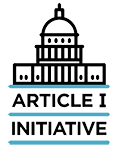Counting by news cycles, it seems like ages ago, but on March 12, Senator Lee spearheaded a common-sense bill aiming to claw back legislative power that Congress previously ceded to the Executive Branch. Rep. Chip Roy (TX-21) followed suit introducing a companion bill in the House that also seeks the same ends. Both chambers of Congress should take up the proposal to reduce the President’s discretion to make public policy by national emergency.
The political moment precipitating this bill was, of course, the President’s invocation of the National Emergencies Act to free up funds for some more bollard fencing on the southern border. This declaration followed from Congress’s decision in the February spending bill to appropriate only a fraction of the amount the President requested for “the wall.” But politics aside, the President’s ability to spend money Congress never truly appropriated in order to advance an agenda without proper legislative approval is a worrisome distortion of the constitutional allocation of powers.
After all, in no less than three places (a few more than that, in fact), the Constitution makes clear that Congress possesses the colloquial “power of the purse.” First, Article I, Section 7 indicates that “raising revenue”—the necessary antecedent to spending it—is a legislative prerogative, with the House having pride of place as the chamber from which all such bills must “originate.” Second, in Article I, Section 8, Congress is given the power “to pay the debts and provide for the common defense and general welfare of the United States,” referred to on occasion as the “Spending Clause.” Third, in Article I, Section 9—the original “bill of rights,” as Chief Justice Marshall saw it in Barron v. Baltimore—the Constitution declares that “[n]o money shall be drawn from the treasury, but in consequence of appropriations made by law . . . .”
Given the Constitution’s general commitment of the power to spend to Congress, not the President—and, in particular, Article I, Section 9’s express prohibition on spending without an appropriation “made by law,” i.e., legislative act—how can it be that the President can spend money without congressional authorization? Well, that’s the rub. See, by at least one count, Congress has enacted 123 separate provisions that give the President special powers when the President declares a national emergency. Congress has also given the President the power, per the National Emergencies Act, “to declare such national emergency” unilaterally, which frees the President to wield any “special or extraordinary power” Congress has already given the President in any one of these 123 laws. In other words, the President simply needs to announce an emergency in order to take advantage of the manifold congressional authorizations to spend money already on the books, some of which at least arguably permit spending money to build things like artistically designed steel slats along the Rio Grande.
This may be technically licit—Congress has codified a dormant “appropriation” that the President may tap into upon declaring a “national emergency”—but it seems a bit difficult to square with the Framer’s design. This isn’t just a matter of structuralist-formalist handwringing over technicalities, either. As Justice Kennedy wrote in Clinton v. New York, individual “liberty is threatened” when “the decision to spend” is “determined by the Executive alone, without adequate control by the citizen’s Representatives in Congress.” At present, south Texas landowners no doubt can relate.
Enter the ARTICLE ONE Act. Senator Lee introduced this bill—the “Assuring that Robust, Thorough, and Informed Congressional Leadership is Exercised Over National Emergencies” Act (whoever comes up with titles in the Office of the Legislative Counsel deserves a bonus)—to reclaim “adequate control” and mitigate this threat to individual liberty. The law would amend the National Emergencies Act by putting a thirty-day cap on the duration of a presidentially-declared emergency absent a “joint resolution of approval” from Congress to extend the period. Absent such a resolution, and the unilaterally-declared emergency automatically expires, along with the President’s ability to wield “special or extraordinary power” during the emergency.
As Senator Lee said in announcing the bill, and as is true so often it seems, elected representatives “troubled by recent emergency declarations . . . only have themselves to blame.” Almost reflexively at this point, any time Congress wants to do something meaningful, it chooses to do so by writing laws that mostly tell the Executive Branch to do something meaningful that Congress will nominally supervise. The inevitable upshot to this state of affairs is that the President has a lot of leeway to do things Congress never actually authorized.
Senator Lee, along with the (all-Republican, as of now) co-sponsors of the ARTICLE ONE Act, would like to do something to change this. The Act would still give the President the ability to respond to true national emergencies, but it would change the status quo by restoring Congress’s role in determining how to proceed when the “emergency” is more of a chronic policy question rather than an acute crisis. As this bill presents Democrats with a chance to rein in a president of the opposite political party, hopefully it can attract co-sponsors from across the aisle as well. And the President has suggested he’d sign this kind of reform. In other words, the ARTICLE ONE Act, at least on paper, has a shot of actually becoming law. Here’s to hoping Congress follows Senator Lee’s lead to do something meaningful to fix decades of legislative dereliction of duty.
***
Joel Nolette is a litigation associate at Mintz Levin in Boston, Massachusetts. As always, please note that all expressions of opinion are solely those of the contributor.

 Joel S. Nolette
Joel S. Nolette 